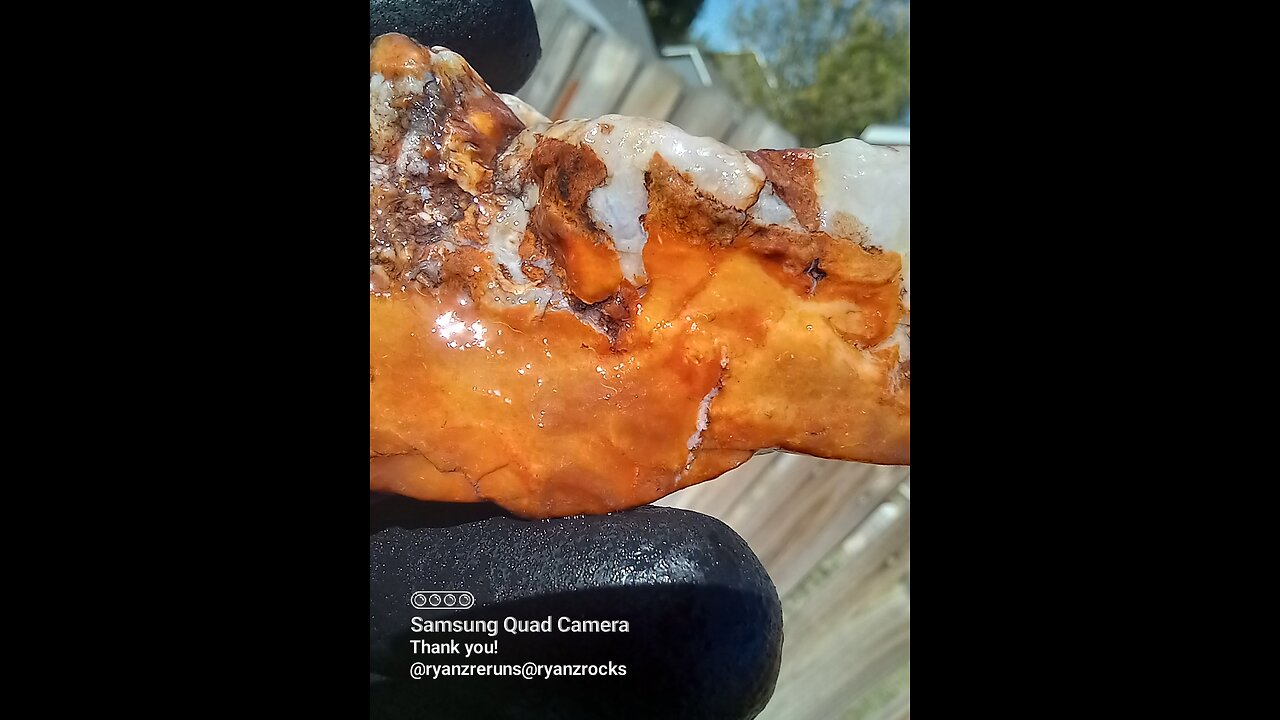Premium Only Content

Chalcedony & Jasper!
The rock in the image appears to be a type of chalcedony, possibly an agate or a similar variety. Here's why:
1. **Coloration and Banding**: The rock has a predominantly white or light gray color with some yellowish-brown inclusions. This kind of coloration and banding is typical for agates, which are a variety of chalcedony.
2. **Translucency**: Chalcedony, including agate, often has a translucent quality, which seems to be present in parts of this rock.
3. **Texture**: The rock's texture looks somewhat waxy or greasy, which is characteristic of chalcedony due to its fine-grained silica composition.
4. **Inclusions**: The yellowish-brown areas could be iron oxide or other mineral inclusions, which are common in agates and give them their varied colors. However, without specific tests like a hardness test, streak test, or chemical analysis, this identification remains speculative. For a more precise identification: - **Hardness Test**: Chalcedony has a hardness of around 7 on the Mohs scale, meaning it should scratch glass but not be scratched by a knife. - **Streak Test**: The streak of chalcedony (if it could be powdered) would typically be white or colorless. - **Microscopic Analysis**: Looking at thin sections under a microscope could reveal the mineral composition more clearly. - **Consulting a Geologist or Using Spectroscopy**: For a definitive identification, especially if this rock might be of value or scientific interest.
The rock in this image appears to be a type of jasper, specifically a brecciated jasper due to its color pattern and texture.
Jasper is an opaque, impure variety of silica, typically composed of quartz and/or chalcedony along with other mineral phases. It's known for its red color, which comes from iron(III) inclusions, but it can also be found in various other colors.
Brecciated jasper is characterized by its broken fragments that have been naturally cemented back together, often showing a mix of colors like red, yellow, brown, and sometimes even hints of purple or pink due to additional mineral impurities or oxidation states.
The texture and the way the colors blend or are segmented in this rock are indicative of this type of jasper. Jasper is commonly used for ornamentation or as a gemstone due to its durability and attractive colors.
-
 LIVE
LIVE
The HotSeat
54 minutes agoLisa Cook Blocks Your Mortgage Relief While Committing Mortgage Fraud – YOU’RE FIRED!
434 watching -
 LIVE
LIVE
The Tom Renz Show
26 minutes agoJudges Are Completely Immune From Lawsuits
80 watching -
 1:18:46
1:18:46
Awaken With JP
2 hours agoCracker Barrel Makes Brilliant Decision, Trump Bans Flag Burning and More - LIES Ep 105
18.3K8 -
 DVR
DVR
Stephen Gardner
59 minutes ago🔥Trump's Moves Leave CNN Speechless!
2644 -
 1:06:37
1:06:37
Sean Unpaved
3 hours agoCincinnati's Sack King Stays: Decoding the Deal & the NFL's Open-Ended Questions
26.3K -
 LIVE
LIVE
StoneMountain64
3 hours agoWARZONE LEGEND RETURNS. GHILLIE SUIT $20k TOURNEY.
191 watching -
 2:11:17
2:11:17
Side Scrollers Podcast
5 hours agoINSANE Illegal Migrant Propaganda Xbox Game + Paypal REFUSES To Pay Dev + More | Side Scrollers
28.9K1 -
 DVR
DVR
SportsPicks
3 hours agoCrick's Corner: Episode 72
3.95K -
 30:39
30:39
ROSE UNPLUGGED
2 hours agoMore of Less: Purpose, Discipline & the Minimalist Mindset
6.36K -
 1:02:18
1:02:18
Timcast
4 hours agoDemocrat States Ignore English Language Mandate For Truckers, DoT Vows Crackdown Amid Trucker Mayhem
151K47